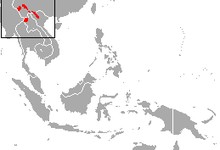
Gibbons are apes in the family Hylobatidae. The family historically contained one genus, but now is split into four extant genera and 20 species. Gibbons live in subtropical and tropical rainforests from eastern Bangladesh to Northeast India to southern China and Indonesia.

The red-shanked douc is an arboreal and diurnal Old World monkey belonging to the Colobinae subfamily. They are endemic to Laos, Vietnam and Cambodia. They are known for their bright colors and exhibit sexual dimorphism through their body size. The species has been declared critically endangered by the International Union for Conservation of Nature, with the main threats being from hunting, habitat loss and pet trade. They are one of three species in the genus Pygathrix, the other two being the black-shanked and gray-shanked doucs.

The lar gibbon, also known as the white-handed gibbon, is an endangered primate in the gibbon family, Hylobatidae. It is one of the better-known gibbons and is often kept in captivity.

The pig-tailed langur, monotypic in genus Simias, is a large Old World monkey, endemic to several small islands off the coast of Sumatra in Indonesia. Its face is black, its fur is black-brown and it has a relatively short tail. It is a diurnal species, feeding in the rainforest canopy on leaves, and to a lesser extent, fruit and berries. Little is known of its natural history, but it is heavily hunted, its populations have been declining rapidly and the International Union for Conservation of Nature has assessed its conservation status as being "critically endangered". It has been included on a list of the World's 25 Most Endangered Primates.

The genus Hylobates is one of the four genera of gibbons. Its name means "forest walker", from the Greek hūlē and bates.

Nomascus is the second-most speciose genus of the gibbon family, Hylobatidae. Originally, this genus was a subgenus of Hylobates, with all individuals considered to be one species, H. concolor.

The pygmy slow loris is a species of slow loris found east of the Mekong River in Vietnam, Laos, eastern Cambodia, and China. It occurs in a variety of forest habitats, including tropical dry forests, semi-evergreen, and evergreen forests. It was originally classified within Nycticebus until it was transferred to the genus Xanthonycticebus in 2022. Two species are recognised, the northern pygmy loris X. intermedius from northern Vietnam, Laos and China and the southern pygmy loris X. pygmaeus from southern Vietnam, Laos and Cambodia. The animal is nocturnal and arboreal, crawling along branches using slow movements in search of prey. Unlike other primates, it does not leap. It lives together in small groups usually with one or two offspring. An adult can grow to around 19 to 23 cm long and has a very short tail. It weighs about 450 g (1.0 lb). Its diet consists of fruits, insects, small fauna, tree sap, and floral nectar. The animal has a toxic bite, which it gets by licking a toxic secretion from glands on the inside of its elbows. The teeth in its lower jaw form a comb-like structure called a toothcomb that is used for scraping resin from tree bark.
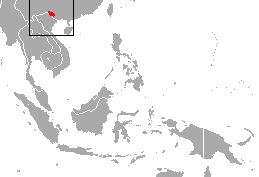
The eastern black-crested gibbon, also known as the Cao-vit black crested gibbon or the Cao-vit crested gibbon, is a species of gibbon from southeast China and northern Vietnam. The term "Cao-vit" originated from the sounds of their calls or songs that villagers of Ngoc Khe, Phong Nam and Ngoc Con communes of Trung Khanh District, Cao Bang Province of Vietnam use to name for them. This name was officially used by gibbon experts since the rediscovery.

The grey-shanked douc langur is a douc species native to the Vietnamese provinces of Quảng Nam, Quảng Ngãi, Bình Định, Kon Tum, and Gia Lai. The total population was estimated at 550 to 700 individuals in 2004. In 2016, Dr. Benjamin Rawson, Country Director of Fauna & Flora International's Vietnam Programme, announced a discovery of an additional population including more than 500 individuals found in Central Vietnam, bringing the total population up to approximately 1000 individuals.
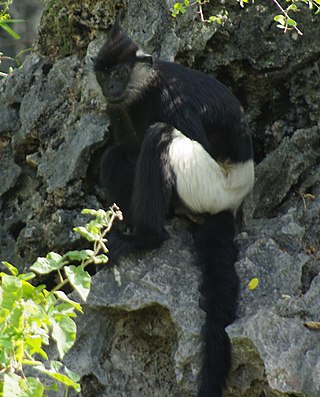
Delacour's langur or Delacour's lutung is a critically endangered species of Old World monkey endemic to northern Vietnam. It is named for French-American ornithologist Jean Théodore Delacour.
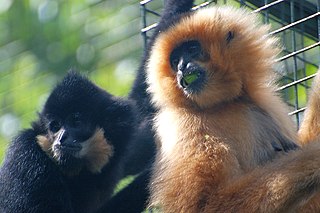
The yellow-cheeked gibbon, also called the golden-cheeked gibbon, the yellow-cheeked crested gibbon, the golden-cheeked crested gibbon, the red-cheeked gibbon, or the buffed-cheeked gibbon, is a species of gibbon native to Vietnam, Laos, and Cambodia. The species was discovered and named after the British naturalist Gabrielle Maud Vassal.

The northern white-cheeked gibbon is a Critically Endangered species of gibbon native to South East Asia. It is closely related to the southern white-cheeked gibbon, with which it was previously considered conspecific. The females of the two species are virtually indistinguishable in appearance.
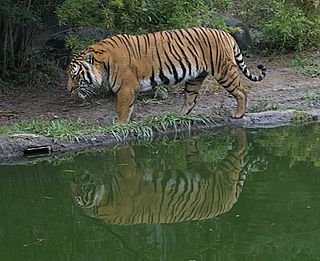
The wildlife of Laos encompasses the animals and plants found in the Lao People's Democratic Republic, a landlocked country in southeastern Asia. Part of the country is mountainous and much of it is still clad in tropical broadleaf forest. It has a great variety of animal and plant species.

The Hainan black-crested gibbon or Hainan gibbon, is a Critically Endangered species of gibbon found only on Hainan Island, China. It was formerly considered a subspecies of the eastern black crested gibbon from Hòa Bình and Cao Bằng provinces of Vietnam and Jingxi County in Guangxi Zhuang Autonomous Region, China. Molecular data, together with morphology and call differences, suggest it is a separate species. Its habitat consists of broad-leaved forests and semi-deciduous monsoon forests. It feeds on ripe, sugar-rich fruit, such as figs and, at times, leaves, and insects.

Ficus neriifolia is a species of fig (Ficus). It is native to Asia, including Bhutan, Burma, China, India, and Nepal.

The southern white-cheeked gibbon is a species of gibbon native to Vietnam and Laos. It is closely related to the northern white-cheeked gibbon and the yellow-cheeked gibbon ; it has previously been identified as a subspecies of each of these.
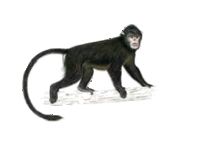
The Myanmar snub-nosed monkey or Burmese snub-nosed monkey or black snub-nosed monkey is a critically endangered species of colobine monkey discovered in 2010 in northern Burma (Myanmar). It was formally described as a novel species of primate in 2011 based on its fur, beard and tail. Two groups of the species were discovered in China in 2011 and 2015, respectively.

The northern buffed-cheeked gibbon is a newly discovered species of crested gibbon which is found in Vietnam, Cambodia, and Laos. Its habitat is in the humid subtropical and seasonal tropical forests of these countries.
Infanticide in non-human primates occurs when an individual kills its own or another individual's dependent young. Five hypotheses have been proposed to explain infanticide in non-human primates: exploitation, resource competition, parental manipulation, sexual selection, and social pathology.

Primate sociality is an area of primatology that aims to study the interactions between three main elements of a primate social network: the social organisation, the social structure and the mating system. The intersection of these three structures describe the socially complex behaviours and relationships occurring among adult males and females of a particular species. Cohesion and stability of groups are maintained through a confluence of factors, including: kinship, willingness to cooperate, frequency of agonistic behaviour, or varying intensities of dominance structures.
